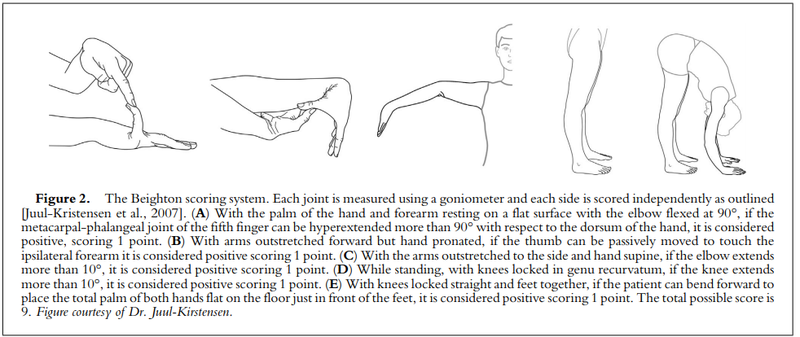Hypermobile Ehlers Danlos Syndrome
Diagnostic Criteria
hEDS is a clinical spectrum from asymptomatic joint hypermobility, to “non syndromic” hypermobility, to hEDS. The latest diagnostic criteria for hEDS were published in 2017 [1]
Criterion 1: Generalised Joint Hypermobility
Must meet Beighton Score for age
| Age | Beighton Score |
| Prepubescent or adolescent | ≥6 |
| Pubescent up until age 50 | ≥5 |
| Over age 50 | ≥4 |
| Patients with Acquired joint limitations | BS 1 point under age requirements AND a positive 5PQ
|
| Five Point Questionnaire for identifying hypermobility (5PQ) |
| Criteria: Two or more “yes” answers suggest joint hypermobility. |
|
Criterion 2: At least 2 features must be present
Feature A: Systemic manifestations of CTD (need ≥5)'
- Unusually soft/velvety skin
- Mild skin hyperextensibility
- Unexplained striaedistensae/rubrae
- Bilateral piezogenic papules of heel
- Recurrent/multiple abdominal hernia
- Atrophic scaring in ≥2 sites
- Pelvic floor, rectal, and/or uterine prolapse in children, men or nulliparous women
- Dental crowding and high or narrow palate
- Arachnodactyly
- Arm span-to-height ≥1.05
- Mitral valve prolapse
- Aortic root dilatation with Z score > +2
Skin extensibility as measured by pinching and lifting the cutaneous and subcutaneous layers of the skin on the volar surface at the middle of the non-dominant forearm as described in Remvig et al, 2009. Skin extensibility of >1.5 cm is considered the upper end of normal. It is likely that the hyperextensibility of the skin in hEDS overlaps significantly with that of “normal” skin. Therefore, extensibility of more than 1.5 cm is “positive.” If extensibility >2.0 cm is present especially in combination with other cutaneous features, such as papyraceous scars, molluscoid pseudotumors and/or subcutaneous spheroids, consider other EDS types as possible alternative diagnoses (mainly cEDS and classical-like EDS)
Feature B: Family history (1 or more first-degree relatives must meet criteria)
Feature C: MSK Complications(need ≥1)
- MSK pain in ≥2 limbs, recurring daily for ≥3 months
- Chronic widespread pain for ≥3 months
- Recurrent joint dislocations or frank joint instability, in the absence of trauma (a or b)
- ≥3 atraumatic dislocations in same joint or ≥2 more atraumatic dislocations in two difference joints occurring at different times
- Medical confirmation of joint instability at two or more sites not related to trauma
Criterion 3: All three prerequisites must be met
- Absence of unusual skin fragility.
- Exclusion of other heritable and acquired connective tissue disorders. In patients with an acquired onnective tissue disorder, additional diagnosis of hEDS requires meeting both Features A and B of Criterion 2. Feature C of Criterion 2 cannot be counted in this situation.
- Exclusion of alternative diagnoses that may also include joint hypermobility by means of hypotonia and/or connective tissue laxity
Article Downloads
File:EDS classifications 2017 - malfait2017.pdf
References
- ↑ Malfait F, Francomano C, Byers P, et al. The 2017 international classification of the Ehlers-Danlos syndromes. Am J Med Genet C Semin Med Genet. 2017;175(1):8-26. doi:10.1002/ajmg.c.31552


